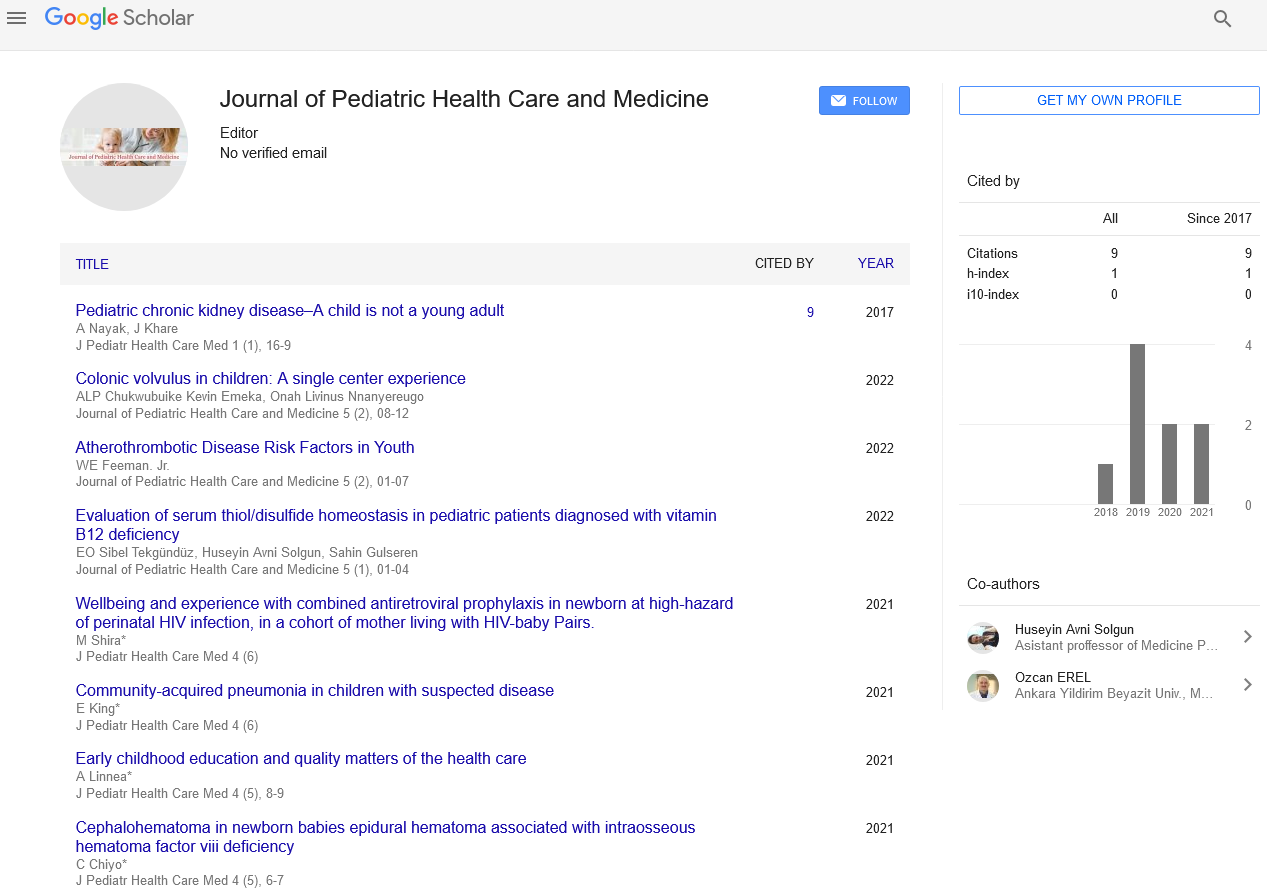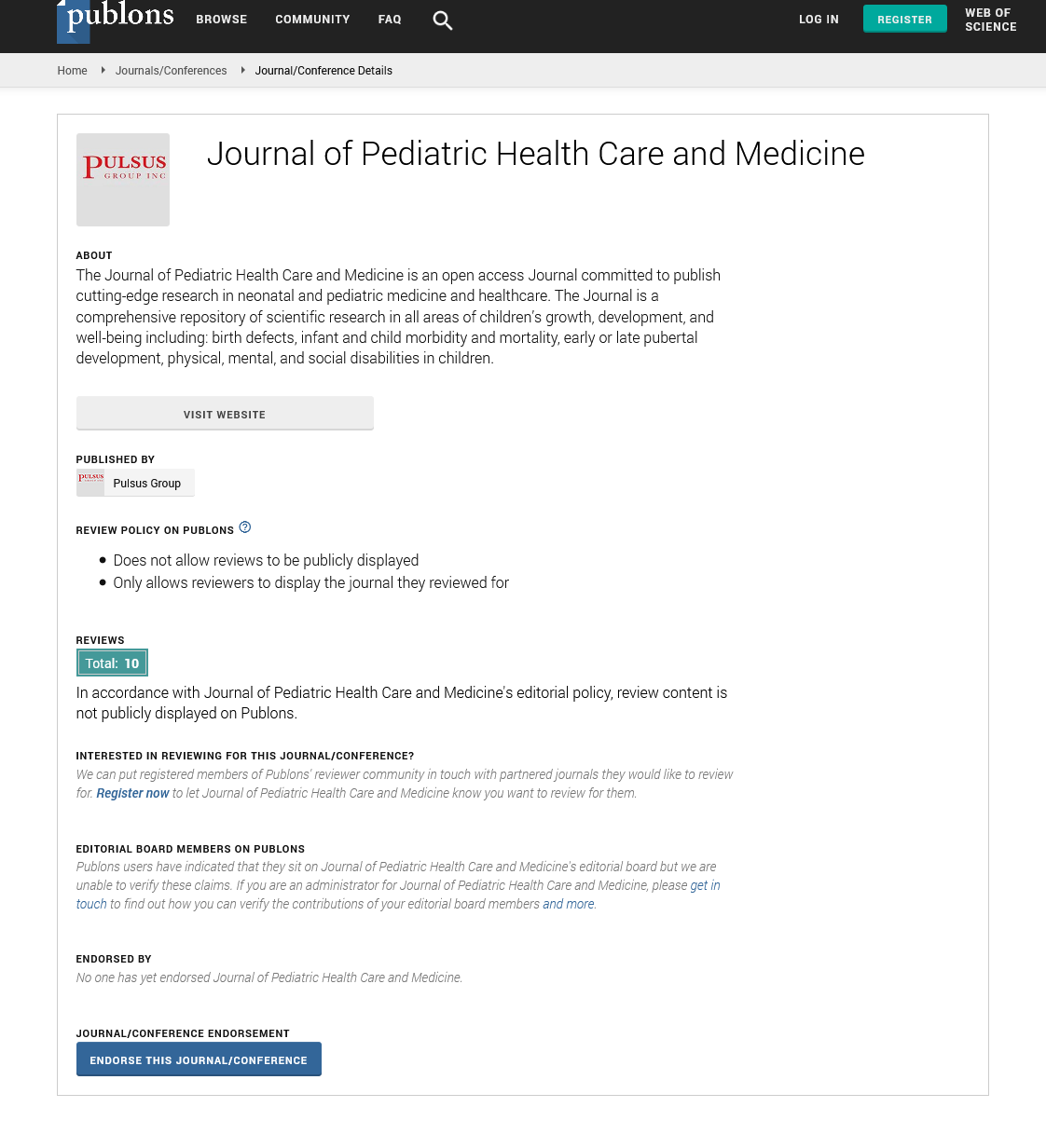Pediatric Beginning Different Sclerosis
#Equally contribution
Received: 13-Apr-2021 Accepted Date: Apr 29, 2021; Published: 10-May-2021
Citation: Muppidi Siri, Department of Pharmacology, Osmania University, Hyderabad, India, e-mail siri.m@gmail.com
This open-access article is distributed under the terms of the Creative Commons Attribution Non-Commercial License (CC BY-NC) (http://creativecommons.org/licenses/by-nc/4.0/), which permits reuse, distribution and reproduction of the article, provided that the original work is properly cited and the reuse is restricted to noncommercial purposes. For commercial reuse, contact reprints@pulsus.com
Abstract
Different Sclerosis (MS) is the commonest among fiery demyelinating illnesses. While the illness pervasiveness is high in grown-ups, recurrence of pediatric beginning various sclerosis (POMS) is low in kids and particularities in this populace have been recognized. We will address in this survey qualities of POMS
Abstract
Different Sclerosis (MS) is the commonest among fiery demyelinating illnesses. While the illness pervasiveness is high in grown-ups, recurrence of pediatric beginning various sclerosis (POMS) is low in kids and particularities in this populace have been recognized. We will address in this survey qualities of POMS
Keywords
Sclerosis; De my elinating, Illnesses.
Introduction
POMS is an uncommon illness and addresses between 3–10% of all MS analysis. Its rate changes as indicated by nations and is assessed around 0.66 to 1.66/100 000 youngsters under 16 or 18 years of age. As indicated by our Kidbiosep partner, we have noticed a recurrence of 30–35 new cases each year in France. The middle period of kids with POMS is 12 years . Youngsters under 10 years of age are likewise influenced, representing 17– 30% of all POMS [6,7]. Sex-proportion shifts as per times of determination: in kids under 10 years old, there are however many young ladies as young men, while in more established youngsters (> 10 years of age) a female transcendence of noticed.
This may propose hormonal obstructions during adolescence. An expansion of backslides and of MS rate during pubescence was as of late seen in Northern American investigations. The commonest clinical introductions are: [1] long lot association (65%), brainstem side effects (37%), optic neuritis (ON) (34%) and intense demyelinating encephalomyelitis (ADEM) (15%). Cross over myelitis is uncommon (7%) and contrasts in clinical introductions as indicated by the period of beginning were again noted. In reality, the event of a contamination in the month going before the first assault in quite a while under 10 is more normal than the individuals who are more than 10 years of age (41% versus 20%). ADEM introductions at beginning are all the more regularly in kids under 10 years (36% versus 9%), just as polysymptomatic introductions (61% versus 40%). The middle time between the first and the second assault is 8 months (range: 1–111 months) and this time is longer for youngsters.
In 2012, symptomatic standards for POMS were set up by the Worldwide Pediatric MS Study Group (IPMSSG). One of the significant contrasts from the past 2007 standards was that POMS can be analyzed after one assault by utilizing MacDonald 2010 standards for scattering in existence. The way that ADEM show (see definition Box 2) can likewise be acknowledged as the debut assault of MS is a significant distinction of POMS. As of late, the 2017 MS models were characterized in grown-ups and these standards can be utilized in youngsters over 11 years of age and if the principal assault isn't an ADEM show. The 2017 rules are as of now under approval in pediatric partners of POMS. Cerebrospinal liquid (CSF) study has again acquired significance lately following the consideration of oligoclonal groups in the 2017 MS standards; their essence would recommend scattering on schedule (DIT).
In youngsters with MS, the presence of oligoclonal groups (OCB) was found in 50 to 90% of kids. OCB are less normally found in youngsters who have introduced their first assault at a time of under 10 years than the individuals who introduced it following 10 years (27% versus 52%). It has likewise been shown that neutrophil-like pleiocytosis prevails in more youthful kids as opposed to lymphocytes as in young people or grown-ups, recommending the plausible job of the natural resistant framework in more youthful youngsters. As of late, other biomarkers of illness movement have been portrayed in POMS. Among them, sCD27, a marker of T cell actuation, is by all accounts a decent indicator of clinically clear MS (CDMS) in youngsters as recently appeared in grown-ups. In 94 kids with an intense demyelinating disorder (ADS), sCD27 in CSF is altogether expanded in kids who have CDMS when contrasted with other non-MS ADS.
In youngsters with MS, the presence of oligoclonal groups (OCB) was found in 50 to 90% of kids. OCB are less normally found in youngsters who have introduced their first assault at a time of under 10 years than the individuals who introduced it following 10 years (27% versus 52%). It has likewise been shown that neutrophil-like pleiocytosis prevails in more youthful kids as opposed to lymphocytes as in young people or grown-ups, recommending the plausible job of the natural resistant framework in more youthful youngsters. As of late, other biomarkers of illness movement have been portrayed in POMS. Among them, sCD27, a marker of T cell actuation, is by all accounts a decent indicator of clinically clear MS (CDMS) in youngsters as recently appeared in grown-ups. In 94 kids with an intense demyelinating disorder (ADS), sCD27 in CSF is altogether expanded in kids who have CDMS when contrasted with other non-MS ADS.
They have likewise shown that it is additionally expanded in patients with scattering in space (DIS) on standard MRI and corresponded with OCB, IgG file and gadolinium enhancement. Light chain neurofilament(Nfl), notable in grown-up MS, is another intriguing marker of POMS: it has been shown that Nfl in CSF in grown-up and pediatric CDMS is expanded and higher Nfl levels in grown-up and pediatric CIS were related with a more limited opportunity to CDMS determination. Continuous investigations in serum Nfl appears to show that this marker is expanded in POMS when contrasted with sound control patients, is connected with clinical and MRI illness action and helpful reaction
Because of the shortage of POMS, the analysis MS ought to be proposed once any remaining differential judgments are avoided. There are a few backsliding incendiary demyelinating infections that can emulate POMS and principally two of them have to be recognized before, for example, AQP4- positive neuromyelitis optica range issues (NMOSD) and antibodies against myelin oligodendrocyte glycoproteins (against MOG) related intense demyelinating infections
Conclusion
POMS has particularities when contrasted with grown-up MS particularly in youthful and pre-pubertal youngsters. Intellectual hindrance is very regular in youngsters with MS, which requires explicit administration. The investigation of pediatric MS would assist with bettering comprehend the pathophysiology of the illness taking into account the brief time frame between the imaginable triggers what's more, the beginning of the sickness.
REFERENCES
- 1. Absoud M, Lim MJ, Chong WK, et al. Paediatric acquired demyelinating syndromes: incidence, clinical and magnetic resonance imaging features. Mult Scler 2013;19:76–86.
- 2. Banwell B, Kennedy J, Sadovnick D, et al. Incidence of acquired demyelination of the CNS in Canadian children. Neurology 2009;72:232– 9.
- 3. Ketelslegers IA, Catsman-Berrevoets CE, Neuteboom RF, et al. Incidence of acquired demyelinating syndromes of the CNS in Dutch children: a nationwide study. J Neurol 2012;259:1929–35.
- 4. Langer-Gould A, Brara SM, Beaber BE, Koebnick C. Childhood obesity and risk of pediatric multiple sclerosis and clinically isolated syndrome. Neurology 2013;80:548–52.
- 5. Reinhardt K, Weiss S, Rosenbauer J, Gartner J, von Kries R. Multiple sclerosis in children and adolescents: incidence and clinical picture - new insights from the nationwide German surveillance (2009–2011). Eur J Neurol 2014;21:654– 9






